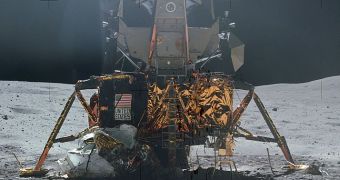Officials with the American space agency announce new collaboration opportunities with the private space sector, this time for landing commercial spacecraft on the Moon. NASA wants to apply the same model to this project as it did for delivering cargo to the International Space Station.
The agency is already working with a number of companies, supporting the development of private spacecraft capable of resupplying the space lab. Orbital Sciences Corporation, of Dulles, Virginia, and SpaceX, of Hawthorne, California, have already successfully launched such missions.
The two companies have also partnered up with NASA to develop manned versions of their cargo capsules, thus ensuring American access to space on American-built spacecraft. The space agency now plans to apply the same partnership model to landing payloads on the Moon.
In a recent announcement, NASA officials said that the organization is looking to support the development of reliable and cost-effective commercial robotic lunar lander capabilities. Gaining this type of access to the Moon would enable both scientific and economic breakthroughs.
The proposed program has been dubbed the Lunar Cargo Transportation and Landing by Soft Touchdown (Lunar CATALYST) initiative. NASA hopes to receive several proposals from private companies soon, and is ready to sign Space Act Agreements (SAA) to support viable proposals.
NASA will not be supporting the development of these new lunar landers through federal funding. Its role in the partnership will be to provide know-how and expertise for the private companies, as well as access to test facilities and equipment, and to computer software for spacecraft control.
“As NASA pursues an ambitious plan for humans to explore an asteroid and Mars, US industry will create opportunities for NASA to advance new technologies on the moon,” explains the NASA deputy associate administrator at the Human Exploration and Operations Mission Directorate, Greg Williams.
“Our strategic investments in the innovations of our commercial partners have brought about successful commercial resupply of the International Space Station, to be followed in the coming years by commercial crew. Lunar CATALYST will help us advance our goals to reach farther destinations,” he adds.
The CATALYST initiative spacecraft could include technology demonstrators, resource prospectors, sample-return capsules, and other types of landers. NASA is interested in small and medium missions, capable of delivering 30-100 kilograms (66-220 pounds) or 250-500 kilograms (550 to 1,100 pounds) of cargo to the lunar surface, respectively.
“In recent years, lunar orbiting missions, such as NASA’s Lunar Reconnaissance Orbiter, have revealed evidence of water and other volatiles, but to understand the extent and accessibility of these resources, we need to reach the surface and explore up close,” concludes the NASA Headquarters director of Advanced Exploration Systems, Jason Crusan.

 14 DAY TRIAL //
14 DAY TRIAL //